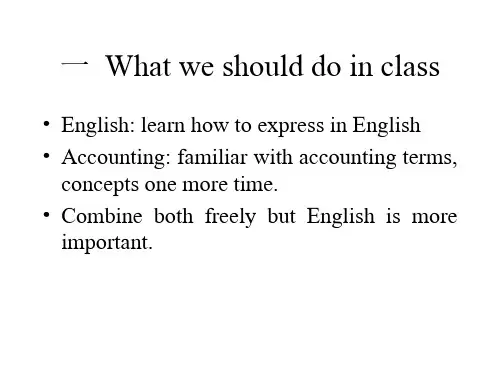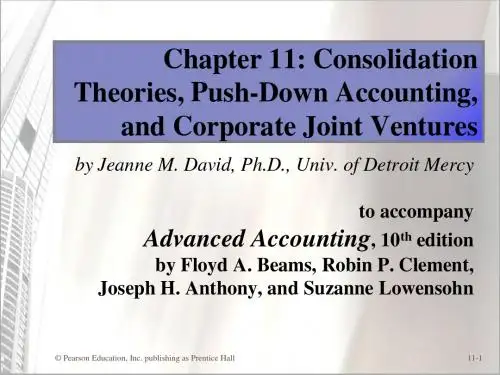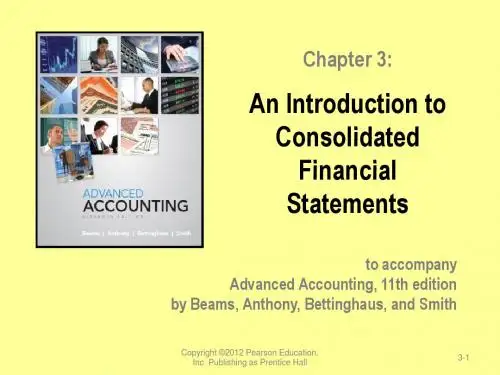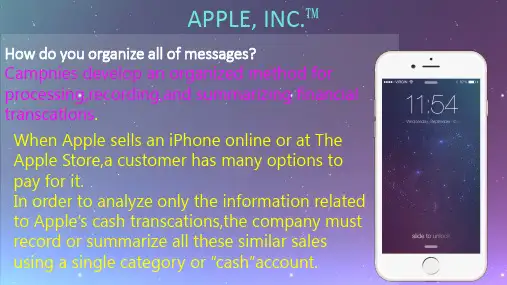- 1、下载文档前请自行甄别文档内容的完整性,平台不提供额外的编辑、内容补充、找答案等附加服务。
- 2、"仅部分预览"的文档,不可在线预览部分如存在完整性等问题,可反馈申请退款(可完整预览的文档不适用该条件!)。
- 3、如文档侵犯您的权益,请联系客服反馈,我们会尽快为您处理(人工客服工作时间:9:00-18:30)。
NCI share – Preferred $10 income $10 dividend NCI share (10% common) $4 income
CI share (90%) $2 dividend
$36 income
$18 dividend
© 2009 Pearson Education, Inc. publishing as Prentice Hall
© 2009 Pearson Education, Inc. publishing as Prentice Hall 10-11
Parent Uses Cost Basis
Parent acquires subsidiary's preferred stock – Use cost method – Investment in subsidiary, PS is at cost – Dividends are recorded as income In the consolidation process – Preferred stock is eliminated at its book value – Noncontrolling interest, PS is recorded at book value of the preferred stock held by others – Investment is removed at its cost and any difference from book value is charged or credited to other paid in capital
© 2009 Pearson Education, Inc. publishing as Prentice Hall 10-8
Allocations
Income allocation: Sol's net income Amortizations Income to allocate Allocated to preferred Allocated to common Dividends Allocated to preferred Allocated to common 50 0 50 (10) 40 30 (10) 20
$500
(105)
395 $45
The book value of preferred is its call price (no arrearage), 105%($100 par value). Dividends are cumulative, so the current dividend is $10 = 10%($100 par value).
Book Value of PS is: Call or redemption price (par value if neither) Plus Dividends in arrears (if cumulative)
© 2009 Pearson Education, Inc. publishing as Prentice Hall
36 18 18 4
2 2
10 10
100 200 40 160 45
396 44 105
10-10
© 2009 Pearson Education, Inc. publishing as Prentice Hall
Parent Uses Constructive Retirement
Parent acquires subsidiary's preferred stock – Investment in subsidiary, PS is recorded at its book value – Any difference between book value and cost of the stock is an adjustment of other paid in capital – This is an owner transaction; no gain or loss is recorded Investment is carried at PS book value – Increase for dividends in arrears – Decrease later when declared
© 2009 Pearson Education, Inc. publishing as Prentice Hall
10-2
Subsidiary Preferred Stock, Consolidated Earnings Per Share, and Consolidated Income Taxation
© 2009 Pearson Education, Inc. publishing as Prentice Hall 10-7
Calculations for Prห้องสมุดไป่ตู้ferred Stock
Cost of 90% of Sol Implied value of Sol Sol's total equity Less book value of preferred stock Book value of common Excess, goodwill $396 $440
Chapter 10: Subsidiary Preferred Stock, Consolidated Earnings Per Share, and Consolidated Income Taxation
by Jeanne M. David, Ph.D., Univ. of Detroit Mercy to accompany Advanced Accounting, 10th edition by Floyd A. Beams, Robin P. Clement, Joseph H. Anthony, and Suzanne Lowensohn
Income from Sol Dividends Investment in Sol Noncontrolling interest share, CS Dividends Noncontrolling interest, CS Noncontrolling interest share, PS Dividends Preferred stock Common stock Other paid in capital Retained earnings Goodwill Investment in Sol Noncontrolling interest, CS Noncontrolling interest, PS
© 2009 Pearson Education, Inc. publishing as Prentice Hall
10-1
Preferred Stock, EPS, and Taxes: Objectives
1. Modify consolidation procedures for subsidiary companies with preferred stock in their capital structure. 2. Calculate basic and diluted earnings per share for a consolidated reporting entity. 3. Understand the complexities of accounting for income taxes by consolidated entities.
10-6
Example: PS Held by Outsiders
Poe buys 90% of Sol for $396 when Sol's equity consists of $100 preferred stock, $200 common stock, $40 other paid in capital and $160 retained earnings. The preferred stock is cumulative, nonparticipating, carries a 10% dividend and is callable at 105% of par value. There is no arrearage. During the year, Sol earns $50 and pays $30 in dividends.
Income allocated to PS is: Current period dividend • Irrespective of amount declared, if cumulative • Declared amount if noncumulative • Potentially more if participative Preferred stock dividend is: Face value x dividend rate • Also consider: • Arrearage • Participation
© 2009 Pearson Education, Inc. publishing as Prentice Hall
10-5
Review of Preferred Stock
Characteristics • Callable, redeemable • Cumulative or noncumulative • Participative or nonparticipative • Limited voting rights Most is cumulative and nonparticipating
© 2009 Pearson Education, Inc. publishing as Prentice Hall 10-4










